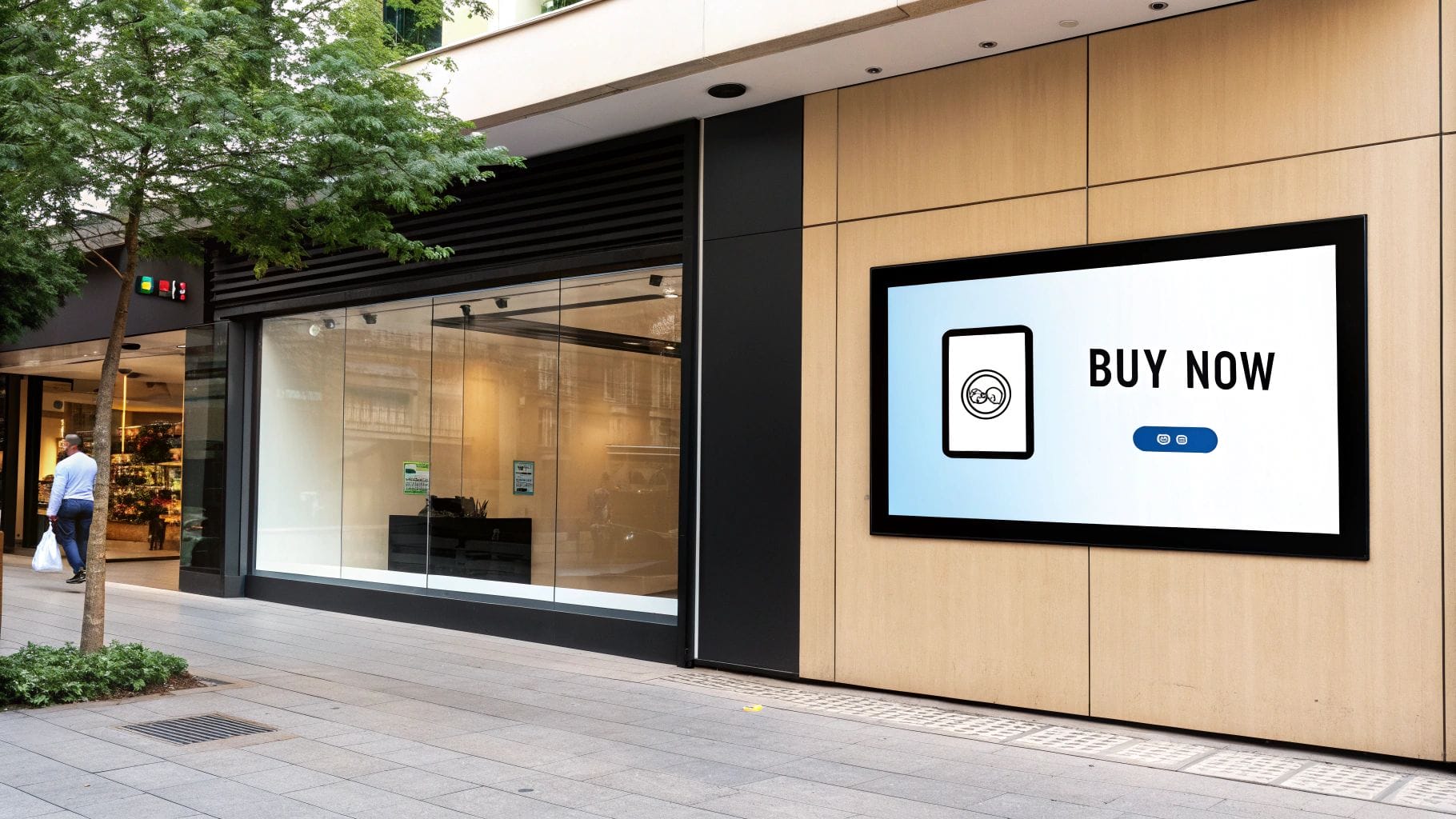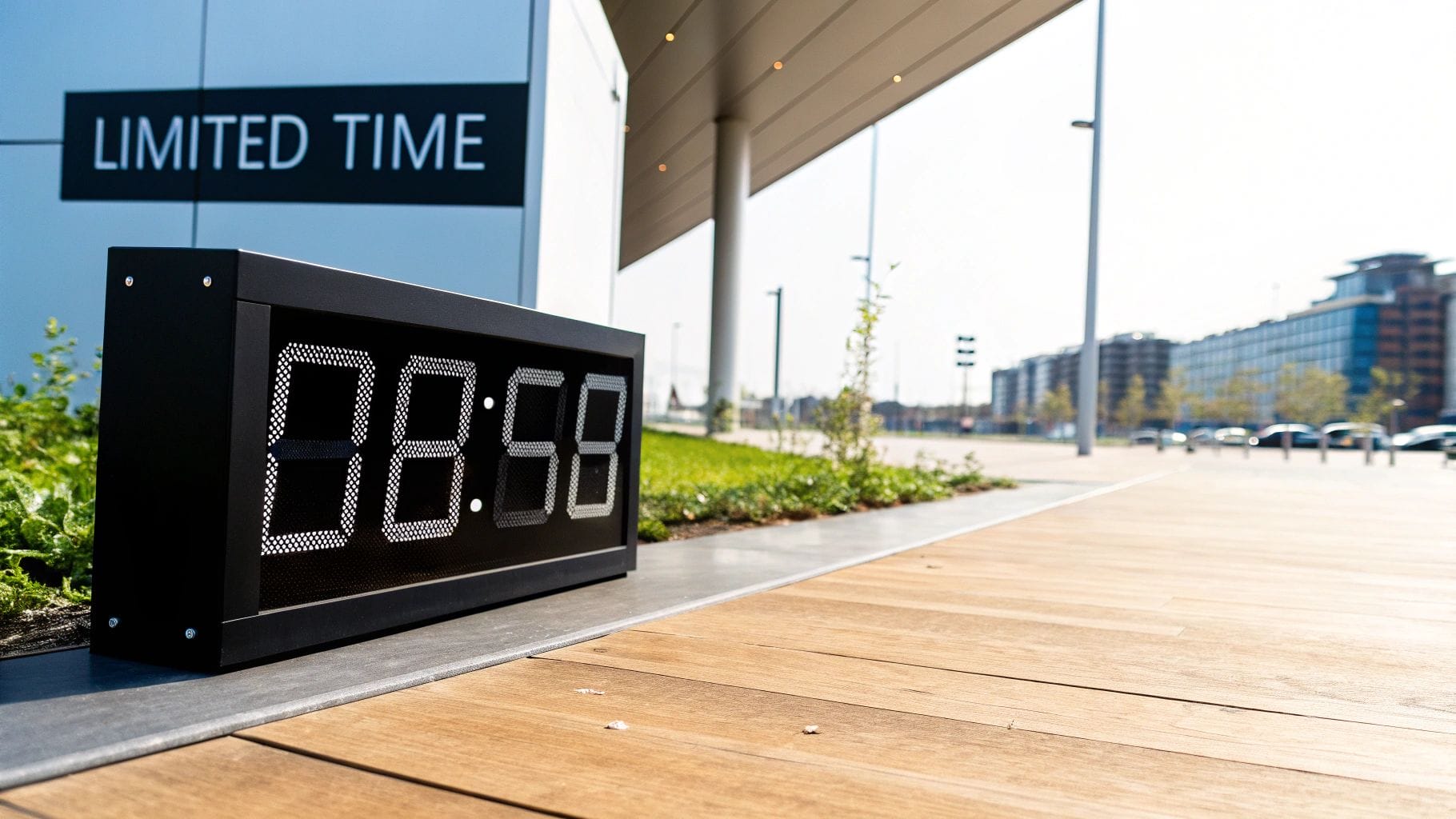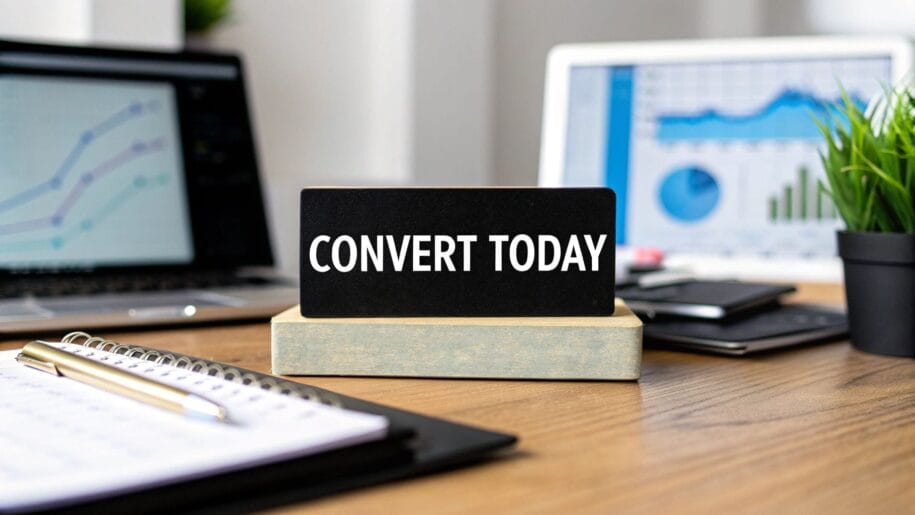Unlocking the Power of the Right Words
Your call to action (CTA) is key to driving conversions. The right phrase can significantly impact your marketing results, whether you’re selling products, offering services, or building an audience. This listicle presents eight effective call to action phrases and explains how to use them. Learn how these powerful words can transform your marketing efforts and achieve your business goals.
1. Act Now / Buy Now
The “Act Now” or “Buy Now” call to action is a cornerstone of direct response marketing. It leverages a sense of urgency to encourage immediate purchases, cutting short deliberation and pushing customers towards conversion. This straightforward approach leaves no room for misinterpretation, clearly signaling the desired action. Its simplicity makes it universally understood across various demographics and platforms.

This call to action deserves its place on the list due to its proven effectiveness in driving conversions, particularly for products and services where immediate purchase decisions are common. Its directness and clarity are key features, eliminating ambiguity and focusing the user’s attention on the desired action. This creates a sense of urgency, especially when combined with limited-time offers or scarcity messaging.
Features and Benefits:
- Direct and unambiguous: The message is crystal clear, leaving no doubt about the intended action.
- Creates urgency: Prompts immediate action rather than procrastination.
- Simple and universally understood: Easily recognizable and interpretable across different languages and cultures.
- Works well with limited-time offers: Amplifies the sense of urgency and scarcity.
Pros:
- Drives immediate action: Effective in converting ready-to-buy customers.
- Clear instruction for users: Provides a simple and understandable path to purchase.
- Effective for e-commerce and sales pages: Ideal for product-focused websites and landing pages.
- High conversion potential for ready-to-buy audiences: Caters to customers who have already made a purchasing decision.
Cons:
- Can feel pushy or aggressive to some users: May alienate customers who prefer a less direct approach.
- Less effective for complex products requiring consideration: Not suitable for products that require research or comparison shopping.
- May repel customers who are still in research phase: Can deter potential customers who are not yet ready to commit.
Examples of Successful Implementation:
- Amazon’s “Buy Now” buttons: The quintessential example of one-click purchasing, streamlining the checkout process and capitalizing on impulse buys.
- QVC’s “Buy Now” buttons during limited quantity offers: Combines the urgency of “Buy Now” with scarcity tactics to drive immediate sales.
- Shopify’s widespread implementation of “Buy Now” across merchant sites: Demonstrates the platform’s recognition of this call to action’s effectiveness in driving e-commerce sales.
Tips for Effective Implementation:
- Pair with a compelling reason to act immediately: Offer discounts, free shipping, or bonuses to incentivize immediate purchases. For example, “Buy Now and Save 20%.”
- Use contrasting colors to make buttons stand out: Visually highlight the call to action to attract attention.
- Test different button sizes and placements: Optimize button design and placement through A/B testing to maximize click-through rates.
- Consider softening with qualifiers like “Buy Now and Save”: Reduce the perceived aggressiveness by adding value propositions.
Popularized By:
- Amazon (one-click buying): Revolutionized online shopping with its streamlined checkout process.
- E-commerce platforms: Widely adopted by platforms like Shopify, BigCommerce, and others.
- Direct response marketers: A staple in direct mail, television, and online advertising.
This call to action is particularly relevant for marketing professionals, entrepreneurs, digital strategists, social media managers, influencers, content creators, and e-commerce businesses looking to boost sales and conversions. It’s a powerful tool for leveraging FOMO (fear of missing out) and driving immediate action, particularly in the context of limited-time offers and scarcity marketing.
2. Get Started / Start Your Free Trial
The “Get Started” or “Start Your Free Trial” call to action (CTA) is a powerful technique for attracting users and converting them into paying customers, especially for products or services that involve a learning curve, like subscription models or SaaS platforms. This approach focuses on minimizing initial commitment and perceived risk by framing the interaction as the beginning of a journey rather than a final purchase decision. Instead of pushing for an immediate sale, it invites users to explore and experience the offering firsthand. This low-friction strategy allows potential customers to familiarize themselves with the product’s value before committing financially.
This CTA works by subtly shifting the user’s mindset. Instead of feeling pressured to buy, they are invited to embark on a trial run. This reduces purchase anxiety and encourages engagement. For example, instead of a daunting “Buy Now” button, a user sees a more inviting “Get Started” button, implicitly promising a guided introduction to the product or service. This invitation to “Get Started” acts as a gentle nudge into the conversion funnel, allowing businesses to nurture leads and demonstrate value over time.
Many successful companies leverage this strategy. Netflix’s “Try 30 Days Free” and Spotify’s “Get 3 months free” are prime examples of using free trial offers to entice users. Similarly, Mailchimp utilizes a simple “Sign Up Free” button, while Dropbox pairs its “Get Started” button with a free storage offer. These examples effectively lower the barrier to entry and encourage users to experience the product’s benefits. Learn more about Get Started / Start Your Free Trial for deeper insights.
Features and Benefits:
- Low-commitment language: Phrases like “Get Started” and “Free Trial” imply a risk-free opportunity to explore.
- Implies a process or journey: This framing resonates with users looking for solutions rather than just products.
- Future-oriented framing: It focuses on the potential benefits users will experience over time.
Pros:
- Reduces perceived risk for users: Encouraging trial usage builds trust and confidence.
- Higher conversion rate for complex products: Free trials allow users to grasp the value proposition before committing.
- Ideal for freemium models and subscriptions: Drives initial sign-ups which can be converted into paying customers.
- Creates opportunity for nurturing campaigns: Businesses can engage trial users with targeted messaging and support.
Cons:
- Lower intent than direct purchase CTAs: Free trial users may not be ready to buy immediately.
- May attract lower-quality leads in some cases: Some users may sign up solely for the free offer without any intention of converting.
- Requires strong onboarding to convert free users to paid: A compelling user experience and clear value proposition are crucial for converting trial users.
Actionable Tips:
- Clearly state what users will get in the trial: Be transparent about features and limitations.
- Minimize form fields to reduce friction: Request only essential information during sign-up.
- Highlight ‘no credit card required’ if applicable: Further reduce perceived risk and encourage sign-ups.
- Show the path forward after trial ends: Clearly outline pricing and subscription options.
This CTA style is particularly effective for SaaS companies, streaming services, and any business offering a product or service with a learning curve. By minimizing the initial commitment and highlighting the value proposition through a free trial or introductory period, businesses can significantly increase user engagement and ultimately drive conversions. This method deserves its place on the list due to its proven effectiveness in onboarding new users and fostering long-term customer relationships.
3. Limited Time Offer / Don’t Miss Out
This call to action (CTA) leverages the powerful principles of scarcity and FOMO (Fear Of Missing Out) to encourage immediate action. By emphasizing the temporary nature of an offer, the limited availability of a product, or a rapidly approaching deadline, you create a sense of urgency that can effectively overcome hesitation and procrastination in the customer’s decision-making process. This strategy taps into a fundamental psychological driver – the aversion to loss – making potential customers more likely to convert before the opportunity disappears.

This CTA deserves its place on the list due to its proven effectiveness across various industries and platforms. Its key features include leveraging the scarcity principle, creating time-based urgency, often incorporating deadlines or countdown timers, and directly appealing to loss aversion psychology. These features translate into several benefits, including driving immediate conversions, creating natural urgency without seeming overly pushy, potentially increasing average order value, and working exceptionally well for special promotions and flash sales.
Examples of successful implementations include Booking.com’s “Only 2 rooms left at this price!” message, Amazon’s limited-time Lightning Deals, Ticketmaster’s “High demand! Tickets selling fast” notification, and the ubiquitous “One Day Only” promotions frequently seen during Black Friday and other shopping events. These examples demonstrate the versatility of this CTA across different product types and price points.
Pros:
- Highly effective at driving immediate conversions
- Creates natural urgency without being pushy
- Can increase average order value
- Works well for special promotions
Cons:
- Effectiveness diminishes if overused
- Must be truthful about limitations; artificial scarcity can damage credibility
- Can create negative associations if customers perceive manipulation
Tips for Effective Implementation:
- Use real-time counters when possible: Dynamically displaying remaining quantities or time left adds to the sense of urgency.
- Be specific about timeframes or quantities: “Sale ends midnight tonight” is more effective than “Limited-time offer.”
- Follow through on deadlines to maintain credibility: Don’t extend “limited-time” offers repeatedly.
- Combine with exclusive benefits for maximum impact: Offer a bonus for those who act quickly, further incentivizing immediate conversion.
When and Why to Use This Approach:
This CTA is particularly effective for:
- Limited-quantity products or services: Where scarcity is genuine and readily apparent.
- Time-sensitive promotions: Such as flash sales, seasonal offers, or early bird discounts.
- Driving sales during slow periods: Creating a sense of urgency can stimulate demand.
- Launching new products or services: Generating initial excitement and buzz.
By understanding the psychology behind this CTA and employing the tips outlined above, marketers, entrepreneurs, and business owners can significantly enhance their conversion rates and drive sales. However, it’s crucial to use this tactic responsibly and ethically, ensuring that any claims of scarcity are genuine and avoiding manipulative practices that could erode customer trust.
4. Learn More / Discover How
“Learn More” and “Discover How” are subtly powerful call-to-action (CTA) phrases that prioritize education and information over immediate conversion. Unlike aggressive CTAs like “Buy Now,” this approach respects the customer’s need for information, especially when dealing with complex products, services, or high-consideration purchases. This method works by inviting potential customers to delve deeper into the features, benefits, and value proposition of your offering before making a decision. It positions your brand as a helpful resource rather than a pushy salesperson, fostering trust and credibility. This is particularly valuable in B2B marketing, thought leadership content, and for products or services with a longer sales cycle.
This CTA deserves its place on the list because it effectively caters to the research phase of the buyer’s journey. It recognizes that informed customers make better decisions and are ultimately more likely to become loyal, long-term clients. The educational focus builds confidence and positions your brand as an expert in its field.
Features and Benefits:
- Education-focused: Prioritizes providing value through information.
- Non-committal and low pressure: Allows prospects to explore at their own pace.
- Respects the buyer’s journey: Acknowledges the need for research and information gathering.
- Positions brand as helpful: Builds trust and rapport with potential customers.
Pros:
- Ideal for complex or high-ticket items: Gives customers the information they need to justify a significant purchase.
- Builds trust through information sharing: Establishes your brand as a reliable source of knowledge.
- Works well for considered purchases: Supports customers in making informed decisions.
- Can qualify prospects through educational content: Engagement with content reveals interest and intent.
Cons:
- Longer conversion path than direct CTAs: Doesn’t lead to immediate sales.
- May not create immediate sales: Requires nurturing leads through the sales funnel.
- Requires quality content to deliver on promise: The “Learn More” CTA must lead to genuinely valuable information.
Examples of Successful Implementation:
- HubSpot: Utilizes “Learn More” CTAs throughout their blog content, directing readers to relevant resources in their resource center.
- Apple: Employs “Learn more about [feature]” on product pages, allowing customers to explore specific aspects of their devices.
- Tesla: Features “Learn More” buttons that lead to detailed specifications and information about their vehicles.
- LinkedIn: Uses “Learn More” CTAs for Premium features, highlighting the benefits and value proposition of their paid services.
Actionable Tips:
- Ensure landing pages deliver valuable information: The content behind the “Learn More” CTA should be comprehensive, engaging, and relevant to the customer’s needs.
- Use to segment audience by interests: Track which educational resources resonate with different segments to personalize future marketing efforts.
- Follow up with more direct CTAs once education is complete: After providing valuable information, guide prospects towards conversion with CTAs like “Get a Quote” or “Request a Demo.”
- Track engagement with educational content as a qualifier: Monitor which content pieces generate the most interest to identify qualified leads.
You can learn more about Learn More / Discover How and explore additional insights into optimizing this strategy.
Popularized By:
- HubSpot
- Content marketers
- B2B companies
- Technology and SaaS businesses
By understanding the nuances of the “Learn More / Discover How” CTA, marketing professionals, entrepreneurs, digital strategists, social media managers, influencers, and e-commerce businesses can leverage its power to build trust, educate their audience, and ultimately drive conversions. This approach aligns perfectly with the principles of social proof in marketing and SEO best practices by providing valuable content that attracts and engages target audiences. It plays a crucial role in mitigating FOMO by offering readily available information and reassuring potential customers they are making an informed decision.
5. Join Now / Sign Up Today
The “Join Now / Sign Up Today” call to action (CTA) leverages the innate human desire for connection and belonging. It positions your offering as part of a community or exclusive group, making it highly effective for membership sites, email lists, online communities, and social platforms. This CTA implies immediate access and encourages prompt action, driving conversions and building a loyal audience. It subtly suggests that by joining “now” or “today,” users are seizing a timely opportunity, further incentivizing immediate signup.

This approach fosters an ongoing relationship with your audience rather than a one-time transaction. Think of platforms like LinkedIn, which uses “Join Now” to connect professionals globally, or Planet Fitness, whose “Join Now” campaigns emphasize the gym’s community aspect. Medium utilizes “Become a Member” to offer exclusive content and a sense of belonging within a writer’s community. Even big box stores like Costco leverage this with their membership signup flows, emphasizing the exclusive deals and benefits available only to members. This CTA deserves its place on this list because it creates a powerful, recurring revenue stream and facilitates the collection of valuable first-party data, leading to higher lifetime value potential. You can learn more about Join Now / Sign Up Today and its potential.
The strength of this CTA lies in its community-oriented language, creating a sense of belonging and suggesting exclusive access. This makes it perfect for building subscription services or fostering engaged communities around a brand. This approach is especially powerful for marketing professionals, entrepreneurs, digital strategists, social media managers, influencers, content creators, and e-commerce businesses aiming to build a loyal customer base and leverage social proof in their marketing.
Pros:
- Builds ongoing relationships: Fosters loyalty and repeat engagement.
- Creates recurring revenue opportunities: Ideal for subscription models.
- Develops valuable first-party data: Enables personalized marketing and better customer understanding.
- Higher lifetime value potential: Increases customer retention and profitability.
Cons:
- Requires ongoing value delivery: You need to consistently provide value to prevent churn.
- May face higher friction due to privacy concerns: Transparency about data usage is crucial.
- Needs clear value proposition: Must overcome subscription fatigue by clearly articulating benefits.
Tips for Effective Implementation:
- Clearly communicate membership benefits: What do members get that non-members don’t?
- Highlight community size to leverage social proof: Showcase the number of existing members to build trust and encourage joining.
- Offer special joining incentives: Limited-time discounts or bonuses can boost initial signups.
- Show what members receive that non-members don’t: Emphasize exclusivity and the value proposition of joining.
By focusing on belonging and exclusivity, “Join Now / Sign Up Today” CTAs can significantly impact your audience growth and business success. They are particularly effective when targeting audiences interested in community, belonging, and exclusive access. Used strategically, these phrases can be a powerful tool for converting casual visitors into loyal members and customers.
6. Claim Your Free [Resource]/Download Now
This call to action (CTA) leverages the power of reciprocity and immediate value to drive conversions. By offering a valuable resource – such as an ebook, template, checklist, free trial, or discount – in exchange for contact information or engagement, businesses can effectively generate leads, build email lists, and nurture prospects. The phrase “Claim Your Free [Resource]” uses compelling ownership language, making the offer feel more personal and desirable. “Download Now” adds a sense of urgency and encourages immediate action. This approach is a staple of successful lead generation strategies, creating a win-win scenario for both the business and the user.
How it Works:
This CTA works by offering a tangible benefit to the user upfront. The prospect receives something they perceive as valuable, while the business gains a lead, an email subscriber, or an engaged user. This exchange establishes a positive first interaction and lays the groundwork for a future relationship. The key is to ensure the offered resource aligns with the target audience’s needs and interests, thereby attracting qualified leads.
Examples of Successful Implementation:
- HubSpot: “Download our free marketing templates” – HubSpot offers various free templates for marketing tasks, attracting leads interested in improving their marketing efforts.
- Neil Patel: “Get a free SEO analysis” – Neil Patel offers a free website audit, appealing to businesses looking to boost their search engine rankings.
- Canva: “Download free design resources” – Canva provides free design templates and elements, attracting users interested in creating visuals.
- Zoom: “Claim your free account” – Zoom offers a free tier for their video conferencing software, allowing users to experience the platform before upgrading to a paid plan.
Actionable Tips:
- Make the resource genuinely valuable: The offered resource shouldn’t be a thinly veiled sales pitch. It should provide real value and address a specific pain point for your target audience.
- Minimize form fields: Long forms can deter conversions. Only ask for essential information like name and email address.
- Follow up quickly after the resource is claimed: Strike while the iron is hot. Send a welcome email, offer additional resources, or invite them to a webinar.
- Create resources that naturally lead to your paid solutions: The free resource should provide a taste of what your business offers, enticing users to explore your paid offerings.
When and Why to Use This Approach:
This CTA is particularly effective for:
- Lead generation: Building an email list and capturing contact information.
- Content marketing: Promoting valuable content and attracting engaged users.
- Building brand authority: Positioning your brand as a helpful resource.
- Driving trial sign-ups: Encouraging users to try your product or service.
Pros:
- High conversion rates due to a clear value proposition.
- Effective for building email lists.
- Creates opportunities for follow-up marketing.
- Positions the brand as generous and helpful.
Cons:
- May attract lower-quality leads interested only in the freebie.
- Requires creating valuable resources, which takes time and effort.
- Higher abandonment if the download process is complex.
Why This Item Deserves Its Place in the List:
The “Claim Your Free [Resource]/Download Now” CTA is a fundamental tactic for online marketing success. Its effectiveness stems from its direct appeal to the user’s self-interest and its ability to initiate a valuable exchange. By providing something of immediate benefit, businesses can capture leads, nurture relationships, and ultimately drive conversions. This approach remains a cornerstone of effective digital marketing strategies.
7. See Results / See How It Works
This call to action (CTA) leverages the power of proof to convert skeptical prospects into customers. Instead of simply telling potential buyers how great your product or service is, “See Results / See How It Works” shows them tangible outcomes, demonstrations, or evidence of its effectiveness. This approach is incredibly powerful because it directly addresses the core concern of many buyers: “Does it really work?”
This CTA works by shifting the focus from claims and promises to concrete evidence. It appeals to the analytical side of decision-making, allowing potential customers to see the value proposition for themselves. It’s particularly effective when dealing with products that have visible results (like skincare), tools with unique functionality (like software), or services with provable outcomes (like marketing agencies).
Examples of Successful Implementation:
- Before/After Galleries: Companies like Proactiv effectively utilize before/after photos to showcase the impact of their products. This visual proof allows potential customers to see real-world results, making the benefits immediately apparent.
- SEO Tool Demonstrations: SEO software providers often use dashboards and reports to demonstrate how their tools improve search engine rankings. They might showcase increases in organic traffic, improved keyword positions, or other quantifiable metrics.
- Success Stories and Testimonials: Weight Watchers highlights member success stories to demonstrate the effectiveness of their program. These testimonials build credibility and demonstrate the potential for positive outcomes.
- Product Demos: Monday.com effectively utilizes “See how it works” product demos to allow potential users to experience the platform’s features and functionality firsthand. This interactive approach provides a compelling demonstration of the tool’s capabilities.
Actionable Tips for Implementation:
- Use Real Case Studies and Testimonials: Authenticity is key. Feature genuine stories and testimonials from satisfied customers.
- Include Specific Metrics Where Possible: Quantify your results whenever possible. Instead of saying “increased website traffic,” say “increased website traffic by 30% in two months.”
- Show, Don’t Tell: Visuals are your friend. Use images, videos, and interactive elements to demonstrate your results.
- Consider Interactive Calculators or Demos: Tools like ROI calculators or interactive product demos can provide personalized insights and allow potential customers to see the potential benefits in their own context.
When and Why to Use This Approach:
This CTA is best suited for situations where:
- Skepticism is a barrier to conversion: If your product or service requires a significant investment or involves a complex process, this CTA can help overcome buyer hesitation.
- Visual results are readily available: This approach works exceptionally well when you can visually demonstrate the impact of your product or service.
- You’re targeting analytical decision-makers: Data-driven individuals will appreciate the evidence-based approach.
Pros:
- Overcomes buyer skepticism
- Appeals to analytical decision-makers
- Works well for visible transformations or results
- Builds credibility through demonstration
Cons:
- Requires strong proof elements to deliver on the promise
- Less effective for intangible benefits
- May extend the sales cycle (as prospects take time to review the evidence)
Learn more about See Results / See How It Works
This CTA deserves its place on the list because it taps into a fundamental principle of persuasion: showing is more powerful than telling. By providing concrete evidence and demonstrating the value proposition, “See Results / See How It Works” builds trust, addresses skepticism, and ultimately drives conversions. This makes it a valuable tool for marketing professionals, entrepreneurs, digital strategists, social media managers, influencers, e-commerce businesses, and anyone seeking to optimize their calls to action. It ties directly into leveraging social proof in marketing and advertising, and is particularly effective when promoting results-oriented services like SEO and other digital marketing initiatives. By appealing to FOMO (fear of missing out) and highlighting the positive outcomes others have achieved, this CTA can significantly boost engagement and drive sales.
8. Reserve Your Spot / Book Now
This call to action (CTA) leverages the principles of scarcity and exclusivity to drive conversions. It creates a sense of urgency and implies limited availability, encouraging immediate action. “Reserve Your Spot” or “Book Now” effectively positions the offer as something valuable and in-demand, playing on the fear of missing out (FOMO). This approach is particularly powerful for events, appointments, reservations, and any offering with limited capacity.
How it Works:
The “Reserve Your Spot / Book Now” CTA works by tapping into our psychological tendency to value things that are scarce. By suggesting limited availability, it creates a sense of urgency and encourages immediate action. The wording itself also implies a degree of privilege – the user is “reserving” or “booking” their place, suggesting they are securing something special.
Examples of Successful Implementation:
- Webinar registration pages: Phrases like “Reserve your seat” create a sense of a limited-capacity event, even in a digital space.
- Restaurant reservation systems (e.g., OpenTable): “Book Now” is a standard and highly effective CTA, particularly during peak dining times.
- Accommodation platforms (e.g., Airbnb): The “Reserve” button for properties reinforces the limited availability and the need to act quickly.
- Conference early-bird registration pages: Combining “Reserve Your Spot” with early-bird discounts adds a double layer of incentive.
Actionable Tips:
- Show remaining spots: When availability is genuinely limited, displaying the remaining spots (e.g., “Only 3 spots left!”) dramatically increases urgency.
- Include exclusivity language in supporting copy: Use phrases like “exclusive access,” “limited-time offer,” or “join the select few” to reinforce the message of scarcity.
- Add social proof: Showing the number of people who have already booked or reserved (e.g., “57 people have already registered”) provides further validation and encourages others to follow suit.
- Create standby lists: When fully booked, offer a standby list. This demonstrates high demand even after the offer is technically unavailable.
When and Why to Use This Approach:
This CTA is most effective for offerings with limited capacity or time-sensitive availability. This includes:
- Events (online and offline): Webinars, conferences, workshops, concerts, etc.
- Appointments: Consultations, appointments with professionals, salon bookings, etc.
- Reservations: Restaurants, hotels, travel bookings, etc.
- Limited-edition products or services: Anything with a finite quantity available.
Pros:
- Highly effective for limited capacity offerings
- Creates natural urgency
- Positions offer as valuable and in-demand
- Works well with countdown elements
Cons:
- Less effective for unlimited digital products or services
- Must be truthful about availability; avoid creating false scarcity
- May require reservation systems or calendars to manage bookings
Why This CTA Deserves Its Place in the List:
The “Reserve Your Spot / Book Now” CTA is a powerful tool for driving conversions by tapping into fundamental psychological principles. Its effectiveness lies in its ability to create urgency and exclusivity, making the offer more appealing and encouraging immediate action. This is especially valuable in competitive markets where capturing attention and driving quick decisions is essential. It’s a classic CTA that remains relevant and effective across various industries and platforms. This approach has been popularized by platforms like Eventbrite, Booking.com, and OpenTable, as well as luxury brands and conference organizers, proving its efficacy across diverse sectors. By understanding how and when to use this CTA, marketers can significantly improve their conversion rates and achieve their business objectives.
8-Point CTA Comparison Guide
| CTA Phrase | Implementation Complexity 🔄 | Resource Requirements ⚡ | Expected Outcomes 📊 | Ideal Use Cases ⭐ | Key Advantages 💡 |
|---|---|---|---|---|---|
| Act Now / Buy Now | Low – simple button design | Minimal – basic CTA element | Immediate conversion for ready-to-buy audiences | E-commerce, flash offers, limited-time deals | Clear, direct prompting that drives instant action |
| Get Started / Start Your Free Trial | Low-Medium – requires trial onboarding | Moderate – sign-up system & trial management | Initiates lead nurturing and gradual conversion | SaaS, subscriptions, freemium models | Reduces risk, encourages users to explore the product |
| Limited Time Offer / Don’t Miss Out | Medium – relies on dynamic elements | Moderate – setup of timers/countdowns | Sparks a quick conversion spike using urgency | Promotions, flash sales, special events | Leverages scarcity to create a sense of urgency |
| Learn More / Discover How | Medium – involves educational content | High – quality content creation needed | Builds trust and educates leads for later conversion | B2B, high-consideration purchases, complex solutions | Establishes credibility and supports informed decisions |
| Join Now / Sign Up Today | Medium – sign-up and community setup | Moderate – membership and support systems | Fosters ongoing engagement and recurring conversions | Membership sites, social platforms, email lists | Cultivates long-term relationships and user loyalty |
| Claim Your Free [Resource]/Download Now | Medium – integration with lead capture | Moderate-High – investment in valuable resource | High lead generation with clear value exchange | Content marketing, lead magnets, resource offers | Encourages exchange of value and builds contact lists |
| See Results / See How It Works | High – demanding proof elements | High – development of demos and case studies | Overcomes skepticism and builds strong credibility | ROI-driven products, tools with visible outcomes | Demonstrates effectiveness through real examples |
| Reserve Your Spot / Book Now | Medium – requires reservation systems | Moderate – integration with scheduling tools | Secures bookings and attendance for limited capacity events | Events, appointments, exclusive offerings | Uses exclusivity and scarcity to prompt timely actions |
Choosing the Perfect Call to Action
This article explored a range of effective call to action phrases, from the direct “Act Now” and “Buy Now” to the more inquisitive “Learn More” and “See How It Works.” We also looked at the power of scarcity with phrases like “Limited Time Offer” and the enticing appeal of free resources with “Claim Your Free [Resource]” or “Start Your Free Trial.” The key takeaway is that choosing the right call to action depends on understanding your audience, your offer, and your overall marketing objective.
Mastering the art of the call to action is invaluable for any business seeking to increase engagement and conversions. Choosing the right call to action is crucial, but it’s equally important to ensure your content itself is engaging and persuasive. To learn more about crafting compelling content that drives conversions, check out this helpful resource on how to create high-quality content. By strategically implementing these phrases and tailoring them to your specific context, you can significantly impact your bottom line and drive meaningful results. Remember, a well-crafted call to action isn’t just a button or a line of text; it’s the bridge between engaging your audience and achieving your business goals.
Ready to amplify your marketing efforts and harness the power of social proof? Notifyio.net provides powerful tools to display real-time customer activity, adding credibility to your calls to action and boosting conversions. Visit Notifyio.net today and see how you can leverage social proof to optimize your marketing strategies.




Leave a Reply